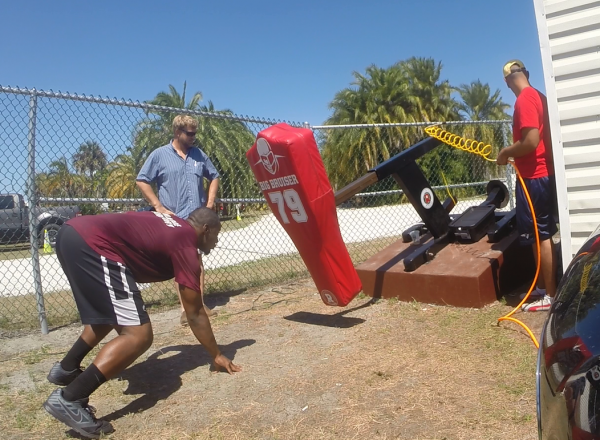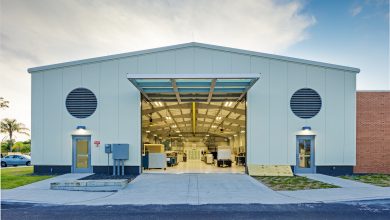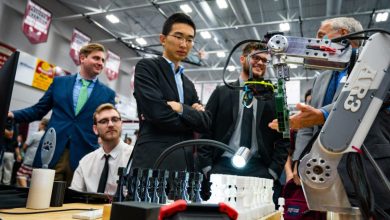Mechanical engineering majors design intelligent football sled
For the love of the game
Inspired by their passion for technology and their love of American football, Steven Campbell and his team of mechanical engineering majors have created a football sled model that is intended to make athletic training more efficient and serve as their senior design project.
“Modern day football sleds provide no means of collecting or storing the data generated when used, and are limited in their ways of varying resistance,” said Campbell, de-facto group leader and football enthusiast.
 Mechanical engineering majors get in the game
Mechanical engineering majors get in the game
Presented with this problem, Campbell and his team discovered that they could swiftly and accurately vary the resistance in a re-designed sled by altering the internal pressure in an attached air cylinder and making the resultant force correspond with the user’s weight.
“The air cylinder that we used in our project also provides us with data showing stroke displacement, which allows the calculation of work performed by the player,” Campbell said. “We also included a light/buzzer to signify the snap of the football.”
The team’s sled comes with an accompanying application which is installed ideally on a tablet or other suitable mobile device and monitored by the user’s coach or supervising trainer.
“One the coach hits ‘Start’ on the tablet, the light/buzzer will turn on and the player will hit the sled,” Campbell explained. “The light triggers the start of a timer, which stops when the player has hit the pad, and then records their reaction time.”
One the reaction time has been recorded, another timer starts and does not stop until the pushing player has completely compressed the pneumatic cylinder. This newly recorded time is used to determine the player’s power.
All the collected data is then recorded on a spreadsheet and made accessible to the user.
Tackling Challenges through Project-Based Learning
Campbell and his team are very excited about the results they have managed to attain in their quest for the perfect football sled, but also pointed out that in their efforts to accomplish this mission, they came face to face with challenges of their own.
“Every time you think you solved one problem, another pops up,” he said. “The biggest challenge our team faced was programming. No one on our team has any experience with LabVIEW before senior design, but we know it pretty well now.”
Campbell’s team of mechanical engineering majors attest to the fact that they would not have bought an actual football sled, had they known what path they were taking at the beginning of the project, as modern sleds are considerably expensive.
“We spent over half our budget on the sled alone. We probably could have saved money by buying steel and constructing our own football sled,” Campbell said.
This project has taught the team a great deal of lessons in planning, some of which they had to learn the hard way, but it has also given them useful real-world experiences that they believe will come in handy when they take on their careers.
“Deadlines!” Campbell exclaimed. “The most important aspect of senior design is completing your project within the time allotted, and I’m confident that will also be the case in the real world.”
Campbell’s advice to future senior design presenters is to not give up, but stay on target and enjoy themselves as they work on something they believe in.
“Stay on target, but try to have a good time while doing it,” he said. “Hard work pays off.”






